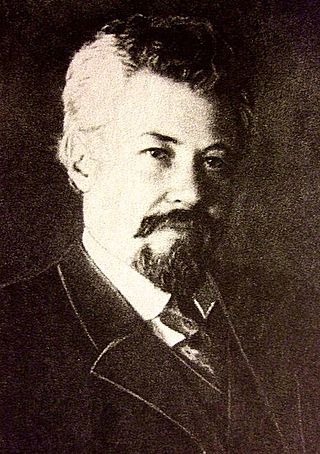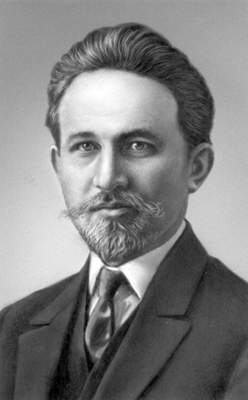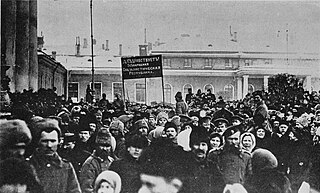
Alexander Fyodorovich Kerensky was a Russian lawyer and revolutionary who led the Russian Provisional Government and the short-lived Russian Republic for three months from late July to early November 1917.

The October Revolution, officially known as the Great October Socialist Revolution in the former Soviet Union, also known as the Bolshevik Revolution, was a revolution in Russia led by the Bolshevik Party of Vladimir Lenin that was a key moment in the larger Russian Revolution of 1917–1923. It was the second revolutionary change of government in Russia in 1917. It took place through an armed insurrection in Petrograd on 7 November 1917 [O.S. 25 October]. It was the precipitating event of the Russian Civil War.

The Russian Revolution was a period of political and social revolution that took place in the former Russian Empire, begun during the First World War. This period saw Russia abolish its monarchy and adopt a socialist form of government following two successive revolutions and a bloody civil war. The Russian Revolution can also be seen as the precursor for the other European revolutions that occurred during or in the aftermath of WWI, such as the German Revolution of 1918.
The history of the Communist Party of the Soviet Union was generally perceived as covering that of the Bolshevik faction of the Russian Social Democratic Labour Party from which it evolved. The date 1912 is often identified as the time of the formation of the Communist Party of the Soviet Union as a distinct party, and its history since then can roughly be divided into the following periods:

Elections to the Russian Constituent Assembly were held on 25 November 1917, although some districts had polling on alternate days, around two months after they were originally meant to occur, having been organized as a result of events in the February Revolution. They are generally recognised to be the first free elections in Russian history.

Matvey Ivanovich Skobelev was a Russian Marxist revolutionary and politician.
The Executive Committee of the Petrograd Soviet, commonly known as the Ispolkom was a self-appointed executive committee of the Petrograd Soviet. As an antagonist of the Russian Provisional Government, after the 1917 February Revolution in Russia, the Ispolkom became a second center of power. It was dissolved during the Bolshevik October Revolution later that year.

Matvei Konstantinovich Muranov was a Ukrainian Bolshevik revolutionary, Soviet politician and statesman.

The Kiev Bolshevik Uprising was a military struggle for power in Kiev (Kyiv) after the fall of the Russian Provisional Government in the October Revolution. It ended in victory for the Kievan Committee of the Bolshevik Party and the Central Rada.

The Russian Provisional Government was a provisional government of the Russian Republic, announced two days before and established immediately after the abdication of Nicholas II. The intention of the provisional government was the organization of elections to the Russian Constituent Assembly and its convention. The provisional government, led first by Prince Georgy Lvov and then by Alexander Kerensky, lasted approximately eight months, and ceased to exist when the Bolsheviks gained power in the October Revolution in October [November, N.S.] 1917.

The April Crisis, which occurred in Russia throughout April 1917, broke out in response to a series of political and public controversies. Conflict over Russia's foreign policy goals tested the dual power arrangement between the Petrograd Soviet and the Russian Provisional Government. The Executive Committee and the full Soviet endorsed Nikolai Sukhanov's "An Appeal to All the Peoples of the World", which renounced war and "acquisitionist ambitions." This appeal conflicted with the Provisional Government's position on annexations, and Foreign Minister Pavel Milyukov responded with the Milyukov note on 18 April declaring Russia's right to Constantinople and the Dardanelles.
The Petrograd Soviet of Workers' and Soldiers' Deputies was a city council of Petrograd, the capital of Russia at the time. For brevity, it is usually called the Petrograd Soviet.

Vladimir Petrovich Nalivkin was a Russian military officer during the Russian Empire's campaigns in Central Asia, entering civil government for the new territory of Russian Turkestan, becoming head of the governing committee and representing the capital Tashkent in Imperial State Duma. Nalivkin went into hiding after the territory fell to communists during the Russian Revolution, and committed suicide in 1918.

The February Revolution, known in Soviet historiography as the February Bourgeois Democratic Revolution and sometimes as the March Revolution, was the first of two revolutions which took place in Russia in 1917.

The Second All-Russian Congress of Soviets of Workers' and Soldiers' Deputies was held on November 7–9, 1917, in Smolny, Petrograd. It was convened under the pressure of the Bolsheviks on the All-Russian Central Executive Committee of the First Congress of Soviets of Workers' and Soldiers' Deputies.
The All-Russian Central Executive Committee of the Soviets of Workers' and Soldiers' Deputies was a permanent body formed by the First All-Russian Congress of Soviets of Workers' and Soldiers' Deputies.

The First All-Russian Congress of Soviets of Workers' and Soldiers' Deputies was held from 16 June to 7 July 1917 in Petrograd in the building of the First Cadet Corps on Vasilyevsky Island. The First All-Russian Congress of Soviets, at which the majority belonged to the Mensheviks and Socialist-Revolutionaries, rejected the resolutions proposed by the Bolsheviks to end the war and transfer all power to the Soviets and adopted Socialist-Revolutionary and Menshevik resolutions proclaiming the full support of the Socialist Ministers and the continuation of the "revolutionary war" on the basis of the rejection of annexations and indemnities.
The Bolshevization of the Soviets was the process of winning a majority in the Soviets by the Russian Social Democratic Labor Party (Bolsheviks) in the second half of 1917. The process was particularly active after the Kornilov Rebellion during September – October 1917 and was accompanied by the ousting from these bodies of power previously moderate socialists, primarily the Socialist Revolutionaries and Mensheviks, who dominated them.
The Political parties of Russia in 1917 were the aggregate of the main political parties and organizations that existed in Russia in 1917. Immediately after the February Revolution, the defeat of the right–wing monarchist parties and political groups takes place, the struggle between the socialist parties and liberals on the one hand, and the struggle between moderate socialists and radicals.

The Tashkent Rebellion was a 1917 conflict between revolutionary forces and loyalists of the Russian Provisional Government, which occurred in Tashkent, in what is now Uzbekistan. The events leading to the conflict began on 14 March 1917 [O.S. 1 March 1917], when local leader Aleksey Kuropatkin received word of the February Revolution. Rule shifted to various political parties in the city, and the Tashkent Soviet was created. As time progressed, Imperial officials were replaced, the soviet gained more power, and a regional soviet was created in addition to the existing council. The Russian Provisional Government began attempting to regain control in April, but the soviets tightly restricted its efforts. Many locals rallied in support of soviet power, and in September and October, conflict began between the parties, ending on 10 October [O.S. September 27].















